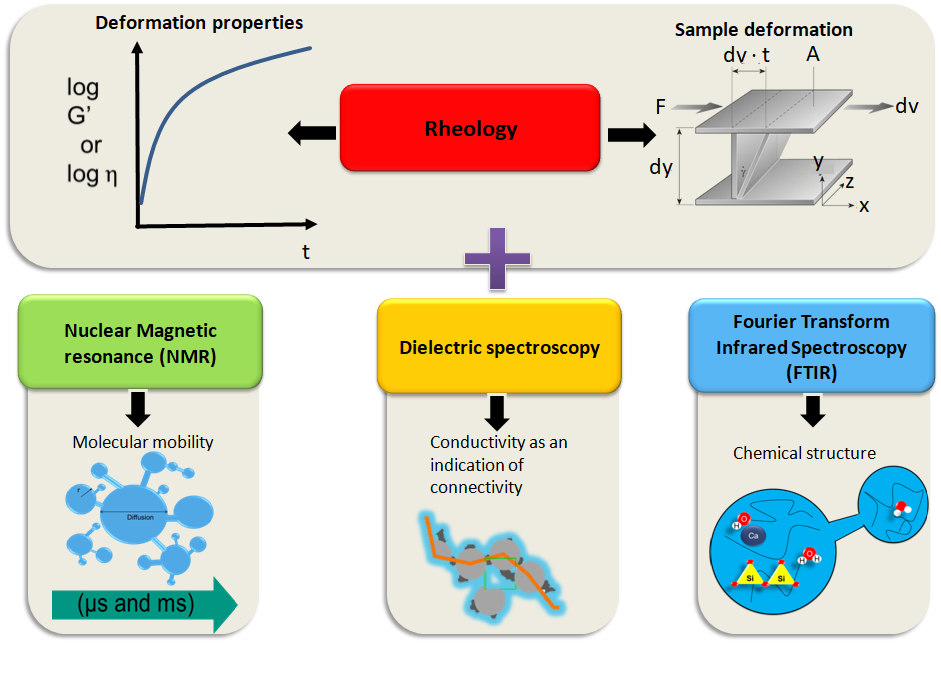18. Rheological properties of fresh concrete and their molecular origin analyzed by novel combined rheological methods
Principal investigator(s) – PI
- Prof. Dr. Manfred Wilhelm
Karlsruher Institut für Technologie (KIT), Institut für Technische Chemie und Polymerchemie
Researcher(s) in-charge – RI
- Dr. Christopher O. Klein
Karlsruher Institut für Technologie (KIT), Institut für Technische Chemie und Polymerchemie - Dr. Roxana Figuli
Karlsruher Institut für Technologie (KIT), Institut für Technische Chemie und Polymerchemie - Nonkululeko W. Radebe
Karlsruher Institut für Technologie (KIT), Institut für Technische Chemie und Polymerchemie
Subject Areas
Concrete materials, Combine-Methods, Method Development
Term
2018-2021
Project identifier
Deutsche Forschungsgemeinschaft (DFG) – Project number 386871659
Project Description
Our goal is to develop different novel strategies and concepts in order to describe the deformation and flow processes of fresh concrete based on molecular processes, taking also into account mesoscopic processes. One important point is the analysis and penetration of the relevant processing operation of fresh concrete using rheology as the main technique and combined it in-situ with complementary methods (dielectric, NMR, SAXS and IR) offering molecular or structural information. Rheology is highly influenced by the morphology and the molecular properties of the investigated materials, e.g. fresh concrete. Rheology can establish the result of the interplay between molecular structure and mechanical properties, the combination of rheology with complementary methods allows gaining unique information about molecular dynamic, structure of time and shear dependent phenomena. Rheo-dielectric: the combination of rheological and dielectric properties can give detailed information about the relation between local molecular relaxation dynamics e.g. water and the macroscopic response to mechanical forces. In mortar or concrete, the cement paste is submitted to different shear stresses during processing and settling, e.g. the pouring of the material into a mould or framework. Therefore, rheological measurements will be carried at different rates for different durations. Rheo-NMR: Providing adequate moisture content in cement-based materials is important during hydration of the cement paste to ensure proper development of their mechanical and durability properties. Water is involved in the formation and deterioration of concrete either as a pure liquid or by carrying aggressive species. 1H-NMR relaxation time studies of hydrating cement based materials combined with rheology can be used to study simultaneously the molecular dynamics via NMR and the corresponding mechanical response for fresh concrete mixtures. Rheo-IR: This method will be implemented during the proposed project to study the chemistry of cement hydration. In the proposed project, the hydration of fresh cement samples will be monitored by means of infrared spectroscopy. The mechanisms of the interaction between individual particles or between particles and the carrier liquid will be investigated with Rheo-IR technique for a better understanding of the rheological behavior of fresh building material suspension. To accomplish first this, we need to develop a new setup that is able to simultaneously measure rheological and infrared spectra with an improved sensitivity to directly correlate mechanical nonlinearity with IR spectroscopy. The new and worldwide unique combined methods will enable the investigation and analysis of the interaction of reactive (hydrating) particles, including the ability to quantify the effects of morphology, chemistry, temperature, time, etc. leading to a more complete model of particle interactions in fresh concrete materials.

Schematic illustrations of the combined methods to analyze unique correlation of macroscopic rheological properties with microscopic chemical changes within cement paste with a controlled temperature and same sample history environment. Rheo-IR is currently being developed in this project.
Publications
in: W. Boshoff, R. Combrinck, V. Mechtcherine, M. Wyrzykowski (Eds.), 3rd International Conference on the Application of Superabsorbent Polymers (SAP) and Other New Admixtures Towards Smart Concrete. SAP 2019, pp. 192-199 (2019)
in: V. Mechtcherine, K. H. Khayat, E. Secrieru (Eds.), Rheology and Processing of Construction Materials, pp. 256–265 (2019)
Materials and Structures 53 (2020)
Journal of Rheology 65 (2021)
